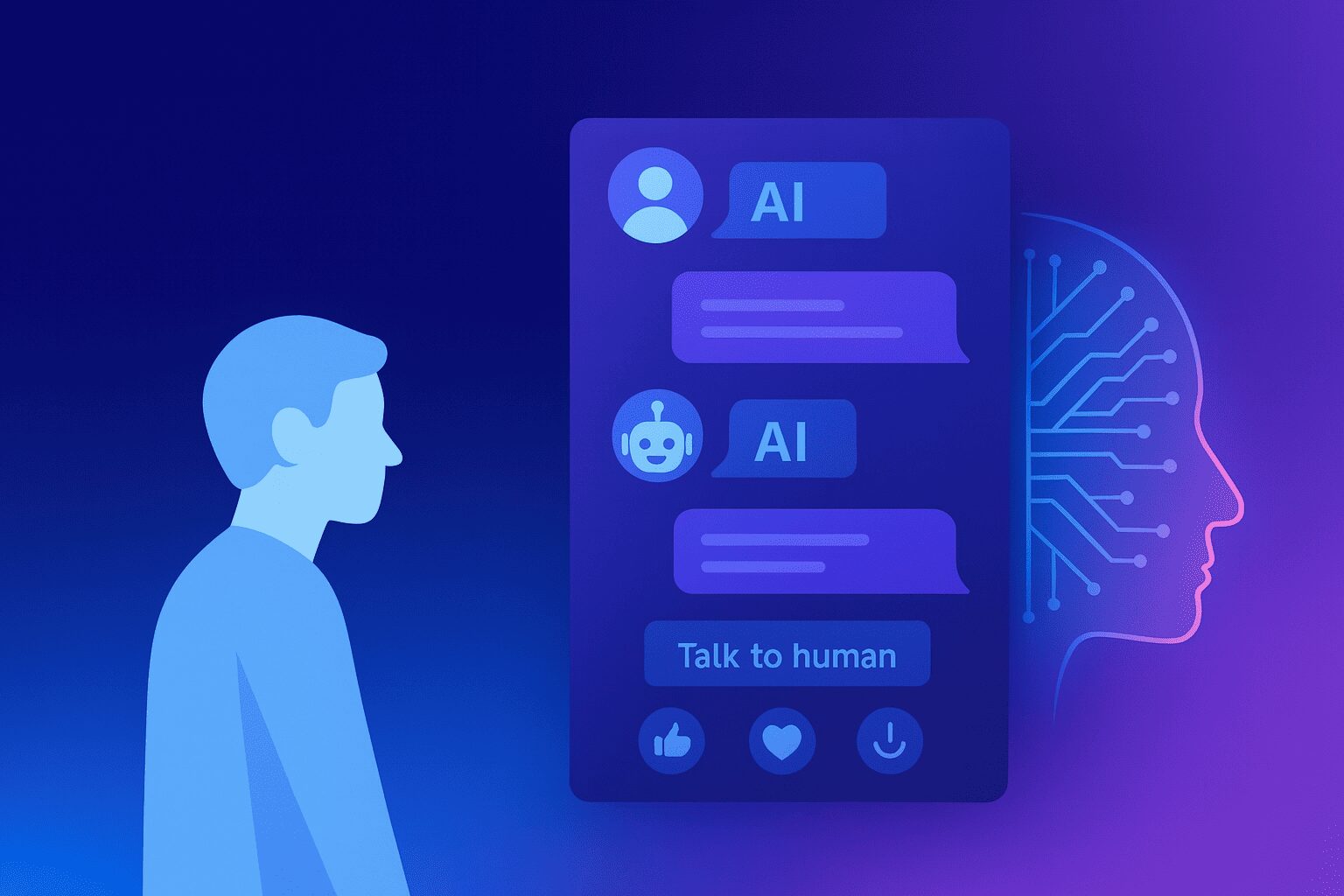Big UX mistakes using AI on websites
1) Unknown scope
Users don’t know what your bot can do. When you hide the scope, you invite dead ends, bad expectations, and deflection to a human that arrives too late. Fix it by stating scope in the first line and offering 3 to 6 quick‑start intents alongside free text. Nielsen Norman Group recommends being upfront about bots, clarifying tasks, and allowing hybrid input (buttons + free text).
2) No clean human fallback
If the only option after a miss is “try again,” satisfaction drops and repeat use disappears. Give people an always‑visible “talk to a person” that carries the transcript to your help desk or CRM so they never repeat themselves. I would also advises visible, well‑labeled chat entry points on relevant pages.
3) Walls of text
Long, meandering answers are high effort, low clarity. Your replies should read like you are helping a busy friend: short, scannable, and ending with a next step. Use bullets, links to proof, and a clear action. Save the long form for when a user explicitly asks for it.
4) Bad placement and timing
Dropping a single “Ask our AI” button on the homepage and calling it a day doesn’t work. Put AI where intent is high. For example, add a “Compare fit” micro‑prompt on product pages, or a “Check contract clause” prompt inside a legal resource hub. You need your chat entry guidance to be clear about not hiding chat and placing it where users actually need it.
5) “Because we said “so” recommendations
Personalized suggestions with no explanation trigger distrust. Say why a recommendation appears and let users dismiss or refine. That small loop teaches your model what to stop pushing while giving users control. This is also good hygiene for transparency requirements that are tightening in multiple jurisdictions.
One observation or bit of feedback I use a lot is “Great AI UX starts by stating what the bot can’t do.”
How to know if your AI is helping or hurting UX
You cannot manage what you do not measure. Track outcomes, not vanity usage. I like the HEART framework (or even the Thumb Up/Down) and adapt it per AI feature: Happiness, Engagement, Adoption, Retention, Task success. Build a simple scoreboard: task success rate vs baseline, time to resolution, adoption and repeat use, and handoff rate to humans plus post‑handoff satisfaction. If handoffs climb and satisfaction falls, your scope is wrong, not your model. Fix the scope before you tune prompts.

Making an AI chatbot genuinely useful
Start with scope and intents: name the 3 to 6 things the bot is great at, plus free text. Offer quick replies that map to common jobs to be done. Keep answers tight with a link to proof and one next step. Always include a human path and pass the transcript forward so users never repeat themselves. Tolerate messy input, add a “rewrite my question” helper and a “save conversation” option. Measure intent quality with per‑turn thumbs or a short survey and prune any dead intent(s).
Designing personalized AI recommendations people actually trust
Disclosing AI the right way
Most people start skeptical if they feel AI is being used. I know I do. A clear, human disclosure sets expectations and, just as importantly, reduces legal risk — especially as transparency obligations tighten under the EU AI Act, California BOT Act (SB 1001), and recent FTC guidance on deceptive AI claims (see FTC AI hub). Place it at the entry point and in the first message, not buried in policy links, which is so frustrating for users.
Starter blueprint you can ship in 28 days
Week 1: Pick one narrow job to win; define scope line and 3–6 intents; decide success metrics using the HEART framework I discussed above.
Week 2: Build the bot skeleton where intent is high; wire in where the human fallback is that will return short answers with links and next steps; add prompt‑rewrite and save‑conversation.
Week 3: Add disclosure and analytics. You want to place disclosure at entry and first message. Then turn on per‑feature dashboards for task success, time to resolution, repeat use, and handoff rate. Once you have this in place you can baseline this against last month’s human‑only flow.
Week 4: Tune or cut. At this time you review downvoted turns and top handoffs. This will help you fix scope first which will show you where to retire dead intents and what to expand based on where the HEART board shows lift.
Implementation checklist
Here we want to think about the design of the actual conversation which could center around a one‑line scope with 3–6 quick intents. This is a short answer format with link(s) to proof and next step and has follow‑ups that branch from the last action.
How are we going to deal with controls and fallback? We want to make sure there’s an “always‑visible” human path that passes the transcript. It can even have the ability to rewrite‑my‑question and save the conversation.
For personalization rules, we want to explain the “why.” Then we can dismiss and refine so we limit to three suggestions unless the user asks for more.
We want to think about placement and labeling next around entry points on high‑intent pages. I suggest that you label plainly as Chat or Ask and avoid blocking pop‑ups.
And always be upfront, which means at entry and first message, we could link to a one‑pager on data use and human review. We may version the disclosure so that it can cross‑check against the EU AI Act, the California BOT Act, and the current FTC posture.
And for metrics, you can consider a HEART per feature, time to resolution, first contact resolution, handoff to human rate and post‑handoff CSAT. We will also want to track repeat use over 30 and 90 days.
Don’t fall into these UI conversation traps when using AI
Here we want to think about the design of the actual conversation which could center around a one‑line scope with 3–6 quick intents. This is a short answer format with link(s) to proof and next step and has follow‑ups that branch from the last action.
How are we going to deal with controls and fallback? We want to make sure there’s an “always‑visible” human path that passes the transcript. It can even have the ability to rewrite‑my‑question and save the conversation.
For personalization rules, we want to explain the “why.” Then we can dismiss and refine so we limit to three suggestions unless the user asks for more.
We want to think about placement and labeling next around entry points on high‑intent pages. I suggest that you label plainly as Chat or Ask and avoid blocking pop‑ups.
And always be upfront, which means at entry and first message, we could link to a one‑pager on data use and human review. We may version the disclosure so that it can cross‑check against the EU AI Act, the California BOT Act, and the current FTC posture.
And for metrics, you can consider a HEART per feature, time to resolution, first contact resolution, handoff to human rate and post‑handoff CSAT. We will also want to track repeat use over 30 and 90 days.
Here are my final takeaways
- Great AI UX starts by stating what the bot can’t do.
- If your handoff rate climbs while satisfaction falls, fix scope before tuning models.
- Label the why behind recommendations, offer a no‑thanks, and keep it to the best three.
- Start small, wire it to outcomes, and measure what matters.
Got questions about implementing AI UI/UX in a website or app?
Reach out to the Spiral Scout team – we build and operationalize AI agents, chat experiences, and personalized recommendations for real business outcomes.



